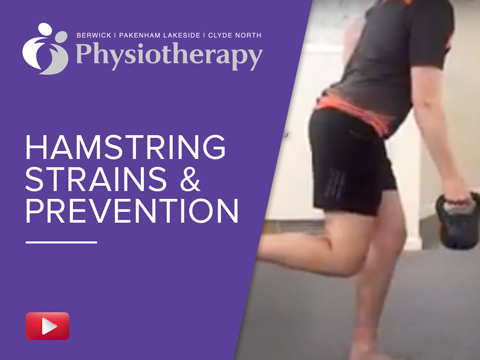As many of us return sport this year after a year-long hiatus thanks to COVID-19, injury prevention should be something at the forefront of our minds – in particular, hamstring injury prevention.
Hamstrings strains are one of the most common sporting injuries. They occur frequently in sports that involve high speed movement including football, field hockey, cricket and running, to name a few. Hamstring strains have one of the highest re-injury numbers especially in soccer, football and rugby.
There are two types of hamstring strains: Type 1 hamstrings injuries commonly occur during fast pace running e.g sprinting or in football and commonly involve the bicep femoris muscle which is seen in the image below; Type 2 injuries are due to over stretching activities usually with the knee fully extended for example high kicking or during the splits. These injuries may occur at slow speed and commonly involve the semimembranosus muscle, also pictured below.
Hamstring strains commonly present with sudden onset of pain into the hamstring region. This pain usually prevents continuation of the activity that has caused the injury. In a type 1 hamstring injury, pain is generally located in the bicep femoris muscle, whereas in a type 2 hamstring injury, pain is usually located near the ischial tuberosity (sit bone) where the hamstring inserts into the bone.
On examination, they are tender over the location of the tear and may present with reduced strength on knee flexion (bending the knee) and have pain on knee extension (straightening the knee out) due to stretching the damaged muscle fibres. In high grade tears, bruising and inflammation can somtimes present in the posterior thigh.
Imaging through ultrasound and MRI can also be used to determine the severity and location of the hamstring strain if it is required by your physiotherapist.
Early management includes a rest, ice, compression and elevation program (RICE principle). After the initial management, the focus is to normalise walking and regain the strength and flexibility in the hamstring. This is achieved by implementing a graduated hamstring strengthening program.
Education on the recurrence of hamstring injuries is important as you are seven times more likely to re-injure a hamstring after a strain. Your physiotherapist can provide you with a hamstring injury prevention program if you play sport and it is highly recommended in athletes that participate in kicking and running sports.
The general recovery time frame for a hamstring strain is between 4-8 weeks, however this is dependent on the initial severity of the injury and the individual’s rate of recovery.
If you have hamstring pain or have had a hamstring strain in the past and want more information on hamstring rehab and specific exercises for a hamstring injury prevention program either for yourself, sporting group or club, please get in contact with one of highly qualified physiotherapists. They are all extremely competent in hamstring strain diagnosis and management, and are available for consultation at our Berwick, Clyde North and Pakenham Lakeside Physiotherapy clinics.

